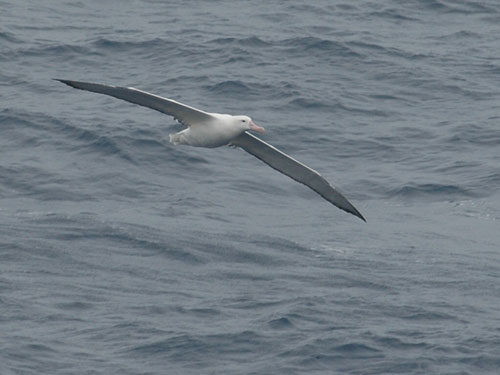Philip Richardson (Department of Physical Oceanography, Woods Hole Oceanographic Institution, USA) writing earlier this year in the journal Progress in Oceanography has watched albatrosses at sea and pondered exactly how they keep aloft without flapping.
The paper's abstract follows:
"Albatrosses fly long distances over the Southern Ocean, even around the world, almost without flapping their wings; this has raised interest in how they perform such a feat. On a cruise to the South Atlantic I observed albatrosses soaring in a characteristic swooping zigzag flight that appears to combine two soaring techniques to gain energy-wind-shear soaring (dynamic soaring) using the vertical gradient of wind velocity and wave-slope soaring using updrafts over waves. The observed characteristic swooping flight is shown in a new illustration and interpreted in terms of the two soaring techniques. The energy gain estimated for "typical conditions" in the Southern Ocean suggests that wind-shear soaring provides around 80-90% of the total energy required for sustained soaring. A much smaller percentage is provided by wind shear in light winds and significant swell when wave-slope soaring dominates. A simple dynamical model of wind-shear soaring is proposed based on the concept of a bird flying across a sharp wind-shear layer as first described by Lord Rayleigh in 1883 and later developed with Pennycuick's (2002) description of albatrosses "gust soaring." In gust soaring a bird exploits structures in the wind field, such as separated boundary layers and eddies in the lee of wave crests, to obtain energy by climbing headed upwind and descending headed downwind across a thin wind-shear layer. Benefits of the model are that it is simple to understand, it captures the essential dynamics of wind-shear soaring, and it provides reasonable estimates of the minimum wind shear required for travel velocity in different directions with respect to the wind. Travel velocities, given in a travel velocity polar diagram, can be combined with tacking to fly in an upwind direction faster than the wind speed located at the top of the wind-shear layer."

A Wandering Albatross glides over the sea surface.
Photograph by Warwick Barnes
Reference:
Richardson, P.A. 2011. How do albatrosses fly around the world without flapping their wings? Progress in Oceanography 88: 46-58.
John Cooper, ACAP Information Officer, 20 November 2011

 English
English  Français
Français  Español
Español